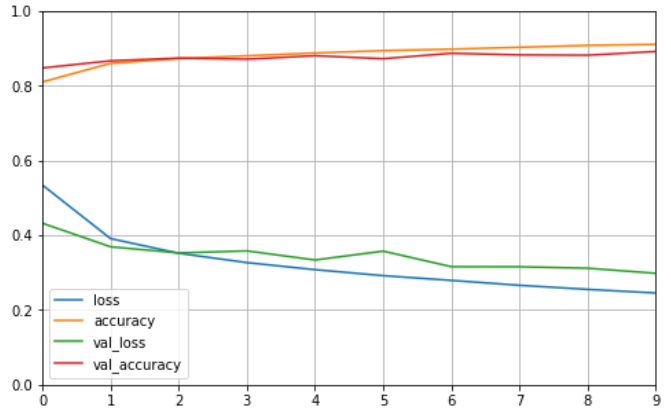一、归一化简介
在对数据进行预处理时,经常要用到归一化方法。
在深度学习中,将数据归一化到一个特定的范围能够在反向传播中获得更好的收敛。如果不进行数据标准化,有些特征(值很大)将会对损失函数影响更大,使得其他值比较小的特征的重要性降低。因此 数据标准化可以使得每个特征的重要性更加均衡。
公式表达为:

二、归一化实战
在这里我们可以将上一节所使用的的图像分类的代码,修改为有将数据归一化的代码,命名为 ------ tf_keras_classification_model-normalize,
代码如下:
import进必要的模块
import matplotlib as mpl import matplotlib.pyplot as plt #%matplotlib inline import numpy as np import sklearn import pandas as pd import os import sys import time import tensorflow as tf from tensorflow import keras print(tf.__version__) print(sys.version_info) for module in mpl,np,pd,sklearn,tf,keras: print(module.__name__,module.__version__)
导入数据
# 导入Keras中的数据 fashion_mnist = keras.datasets.fashion_mnist (x_train_all,y_train_all),(x_test,y_test) = fashion_mnist.load_data() # 将数据集拆分成训练集与验证集 # 将前5000张图片作为验证集,后55000张图片作为训练集 x_valid,x_train = x_train_all[:5000],x_train_all[5000:] y_valid,y_train = y_train_all[:5000],y_train_all[5000:] print(x_valid.shape,y_valid.shape) print(x_train.shape,y_train.shape) print(x_test.shape,y_test.shape)
在这里我们可以查看下数据集中的最大最小值
print(np.max(x_train),np.min(x_train))
代码执行结果如下:
255 0
即训练集中最大值为255,最小值为0
接下来我们将数据集中的数据进行归一化处理
from sklearn.preprocessing import StandardScaler scaler = StandardScaler() x_train_scaled = scaler.fit_transform( x_train.astype(np.float32).reshape(-1,1)).reshape(-1,28,28) x_valid_scaled = scaler.transform( x_valid.astype(np.float32).reshape(-1,1)).reshape(-1,28,28) x_test_scaled = scaler.transform( x_test.astype(np.float32).reshape(-1,1)).reshape(-1,28,28)
在这里 scaler.fit_transform 即是把 x_train 作归一化处理的方法,但这个方法的输入参数要求是二维的,而我们的 x_train 是三维的([None, 28, 28]), 故需先将其转化为二维的。
上述 x_train.astype(np.float32).reshape(-1, 1) 的作用就是将三维数据转化为二维([None, 784])。
但是在将数据转换为二维进行归一化之后,还需在转化回三维,这样才能传入模型中进行训练。reshape(-1, 28, 28)的作用就是如此。
这里还需注意的是训练集的归一化方法为 scaler.fit_transform,验证集和测试集的归一化方法为scaler.transform。
归一化后我们可以再查看下训练集中的最大最小值:
print(np.max(x_train_scaled),np.min(x_train_scaled))
结果为:
2.0231433 -0.8105136
这样一来将数据归一化处理就做好了。
再构建同样的模型进行训练
model = keras.models.Sequential([ keras.layers.Flatten(input_shape=[28,28]), keras.layers.Dense(300,activation='relu'), keras.layers.Dense(100,activation='relu'), keras.layers.Dense(10,activation='softmax') ]) #配置学习过程 model.compile(loss = 'sparse_categorical_crossentropy', optimizer='sgd', metrics=['accuracy'])
#开启训练 history = model.fit(x_train_scaled,y_train,epochs=10, validation_data=(x_valid_scaled,y_valid))
训练过程打印如下:
Train on 55000 samples, validate on 5000 samples Epoch 1/10 55000/55000 [==============================] - 10s 175us/sample - loss: 0.5347 - accuracy: 0.8103 - val_loss: 0.4324 - val_accuracy: 0.8478 Epoch 2/10 55000/55000 [==============================] - 8s 149us/sample - loss: 0.3912 - accuracy: 0.8603 - val_loss: 0.3692 - val_accuracy: 0.8670 Epoch 3/10 55000/55000 [==============================] - 15s 273us/sample - loss: 0.3520 - accuracy: 0.8729 - val_loss: 0.3528 - val_accuracy: 0.8742 Epoch 4/10 55000/55000 [==============================] - 11s 195us/sample - loss: 0.3269 - accuracy: 0.8804 - val_loss: 0.3582 - val_accuracy: 0.8714 Epoch 5/10 55000/55000 [==============================] - 10s 185us/sample - loss: 0.3080 - accuracy: 0.8878 - val_loss: 0.3339 - val_accuracy: 0.8806 Epoch 6/10 55000/55000 [==============================] - 11s 202us/sample - loss: 0.2919 - accuracy: 0.8942 - val_loss: 0.3576 - val_accuracy: 0.8726 Epoch 7/10 55000/55000 [==============================] - 7s 136us/sample - loss: 0.2793 - accuracy: 0.8981 - val_loss: 0.3159 - val_accuracy: 0.8872 Epoch 8/10 55000/55000 [==============================] - 8s 149us/sample - loss: 0.2661 - accuracy: 0.9031 - val_loss: 0.3157 - val_accuracy: 0.8828 Epoch 9/10 55000/55000 [==============================] - 9s 166us/sample - loss: 0.2552 - accuracy: 0.9083 - val_loss: 0.3118 - val_accuracy: 0.8820 Epoch 10/10 55000/55000 [==============================] - 8s 152us/sample - loss: 0.2455 - accuracy: 0.9110 - val_loss: 0.2982 - val_accuracy: 0.8920
可以看出相比上一节的训练结果,使用归一化后的训练效果更好。
也可以将训练结果可视化
#变化过程可视化 def plot_learning_curves(history): pd.DataFrame(history.history).plot(figsize=(8,5)) plt.grid(True) #打印网格 plt.gca().set_ylim(0,1) plt.show() plot_learning_curves(history)
打印结果为:

最后可以对测试集进行评估
#测试,评估 model.evaluate(x_test_scaled,y_test)
输出结果为:
loss: 0.2733 - accuracy: 0.8825
即精度为0.8825